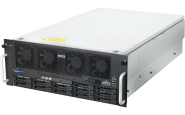 In this video from SC14, Alan Chang from Quanta describes the company’s new QuantaGrid Q71L-4U four-socket system with 96 DIMM sockets for a capacity of 6 Terabytes of memory. The big-memory system is tallor-made for large-scale analytics and HPC workloads.
In this video from SC14, Alan Chang from Quanta describes the company’s new QuantaGrid Q71L-4U four-socket system with 96 DIMM sockets for a capacity of 6 Terabytes of memory. The big-memory system is tallor-made for large-scale analytics and HPC workloads.
Complemented by state-of-the-art low-power and high-speed DDR4 technology, new instructions from Intel Xeon E5-2600 v3 processors plus higher QPI link, the latest QCT servers present a 70% technical computing performance boost (measured with Linpack) and 65% increase in JAVA performance (measured with SPECjbb *2013-MultiJVM).
Full Transcript:
insideHPC: What are we looking at here? What is this device?
Alan Chang: Well, this one is a four socket system we kind of introduced this year and it has the highest memory capacity. The total system has 96 DIMM sockets. So, it can run on six terabytes of memory for– in memory computing. So, we also have plenty of PC extension slots in the back, right? So, for IO’s intensive system requirements, it’s really great system for it. And we also have designed this for server stability. Like this, all the frame module was hot swappable. All the hard drive in the front it was hot swappable. This is very enterprise great stuff. So, if you’re looking for hardware, yeah, here it is.
insideHPC: This looks like it’d be great for maybe big data analytics then.
Alan Chang: Absolutely, that’s what we’re targeting it to.
insideHPC: Okay, excellent. So, what else we got in the booth that’s cool?
Alan Chang: Actually we’ve got a prototype machine in the back, too.
insideHPC: So, this is not a product yet, you say?
Alan Chang: This is not a product yet. So, as you know, Quanta is really big in OCP, which is open compute. So, this is a first OCP-based product, which can accommodate up to 12 GPU cards. 12 GPU cards. Right. [?] with the one motherboard or two motherboards. If you have a very intensive GPU requirement, you can put just one motherboard with dual socket, and if you want more computing power, you can have an optional second motherboard right here. And then, you have a 3.5 inch drive for storage. Everything is hard swappable and is toolless, too. You can just pop in the drive and then close it, and that’s it.
insideHPC: So, that’s a lot of GPU power you can put in there. Does Facebook use GPUs?
Alan Chang: At this moment, no, but we believe there’s a broader market which is required GPO solutions according to the HPC market. And we want to introduce a cloud product into HPC and hopefully they can adapt this and take some advantages of the product.
insideHPC: What do you think open compute offers for HPC in general? What would you say?
Alan Chang: Look at this. First thing is you look at this, is the first question you’re going to ask, what kind of system can this– what kind of power consumption would this system take? OCP has centralized power, so what you have– when you have 12 kilowatt of centralized power, power consumption is not going to be a problem for individual system anymore. So, you can put in as much GPU card as you want.
insideHPC: Okay. Pretty exciting. What are people saying? You’re showing this as a potential product, what are you hearing from the customers?
Alan Chang: Well it is, and then people excited about this and they love the flexibility of having one motherboard or two motherboards. And then they could just kind of– depends on what their workload. They can plug in as much as they want.
See our Full Coverage of SC14. * Sign up for our insideHPC Newsletter.




